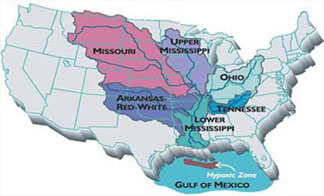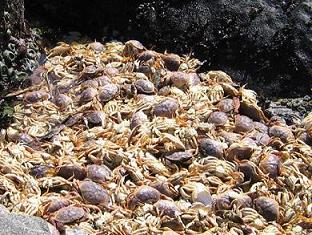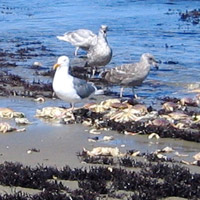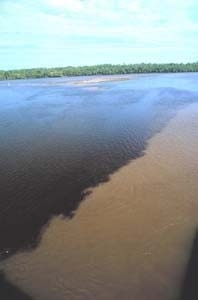Gulf of Mexico hypoxia and the Gulf of Mexico oil spill
Contents
Gulf of Mexico Dead (Hypoxic) Zone
Hypoxia, or low oxygen, develops near the mouth of the Mississippi River every summer as a result of excess nutrients that are introduced principally via the Mississippi River. These excess nutrients trigger algal blooms that are eventually decomposed by oxygen-consuming bacteria. As a result, oxygenin the bottom waters of the Gulf (Gulf of Mexico large marine ecosystem), below about 25-30 feet, drops to stressful and sometimes lethal levels.  Credit: NOAA
Credit: NOAA
Low oxygenwaters have already been recorded this year but the full geographicextent of the affected area will not be known until later in the summer. In addition to the hypoxiathat develops to the west of the Mississippi Delta, hypoxiahas also developed periodically to the east of the delta in the Mississippi Bight. Winds, currentsand storms also affect oxygen conditions in Gulf (Gulf of Mexico large marine ecosystem)waters. The area affected can spread from the mouth of the Mississippi west towards Texas covering, on average for past five years, about 7,000 square miles of theContinental Shelf.
Hypoxia and the Oil Spill
NOAA (National Oceanic and Atmospheric Administration (NOAA), United States)-supported monitoring cruises conducted by the Louisiana Universities Marine Consortium have already detected some low-oxygenzones. Recent oilflow trajectories have oil approaching sites where Mississippi Riveroutflow occurs. It is likely that water containing oilwill intersect with this outflow and influence the dead zone (Hypoxia fact sheet) formation. Heavy use of dispersant (Oil spill control technologies)s (Oil spill control technologies)means that much of the oilis probably in the water column and may be moving closer to the region where the hypoxiczone typically forms than the surface accumulation might suggest.
According to researchers who have been studying hypoxiafor decades, oil could exacerbate this year’s dead zone (Hypoxia fact sheet). For example, oilon the surface of the water could restrict the normal process of atmospheric oxygenmixing into and replenishing the water column concentrations. In addition, microbes (Bacteria)in the water that break down oiland dispersant (Oil spill control technologies)also consume oxygen; this could lead to further oxygendepletion. It is also possible that the microscopic animal grazers of algae, or zooplankton, could be affected, thus allowing more of the hypoxia-fueling algae to grow.
There are factors related to the oil spillthat could lessen the severity or extent of the hypoxiczone. For example, the large, near-surface algal blooms that ultimately fuel the bottom water decomposition that produces hypoxicconditions could be reduced if the oilor dispersant are toxic to the algae or reduce the light penetration required for algal growth. If such a reduction in algal growth occurs on a large enough scale, it is possible that this process could reduce the size and/or severity of the hypoxiczone. It is important to recognize that oil-related impacts could, in many cases, exacerbate the effects of hypoxia. For example, hypoxiacan damage the health of organisms such as shrimp and fish, affecting their growth and reproductive potential.File:Hypoxia2.jpg.html  Credit: Elizabeth Gates, courtesy of PISCO; NSF
Credit: Elizabeth Gates, courtesy of PISCO; NSF
Oilalso can have sublethal effects on the eggs, larva, and early life stages of fish, so there is the potential that these stressors can be additive, and each stressor may increase the susceptibility to the harmful effects of the other. In fact, brown shrimp exposed to polycyclic aromatic hydrocarbons (PAHs), a common pollutant associated with oil, has been shown to induce stress at a higher level of dissolved oxygenrelative to clean environments.
As part of [[NOAA (National Oceanic and Atmospheric Administration (NOAA), United States)]’s]longstanding and ongoing research into the causes and effect of the Northern [[Gulf (Gulf of Mexico large marine ecosystem)]of Mexico] HypoxicZone, efforts will be made this year to further evaluate the complex interactions between hypoxiaand the oil spill.
Hypoxia has clearly stressed or killed some organisms in the Gulf (Gulf of Mexico large marine ecosystem)off Louisiana. This existing stress, therefore, likely makes the food web more susceptible to impacts from other stresses such as the oil spill. Some examples of this are provided in the prior question. However, since these food web effects may be subtle, even though potentially widespread and damaging, it is difficult to address this question definitively without substantial additional research.
Past and Future Directions for Hypoxia and Oil Spill Research
Through NOAA (National Oceanic and Atmospheric Administration (NOAA), United States)research funding directed at the hypoxiczone and other NOAA (National Oceanic and Atmospheric Administration (NOAA), United States)programs over the past 30 years, a significant data base has been established that includes the benthic community, phytoplankton, zooplankton, shrimp, fish, and chemical constituents.
These data can be used as a baseline to address impacts related to the oil spill. The hypoxiaresearch programs also have recently supported the development of sophisticated biogeochemical mathematical models that could be used, with certain modifications, to understand and quantify the impacts from the oil spill and help to definitively link causes and effects.
NOAA (National Oceanic and Atmospheric Administration (NOAA), United States)is funding (through the NGOMEXhypoxia program) a number of research cruises this spring and summer that are designed to collect data on essential physical, chemical, and biological properties in the waters west of the Mississippi River.
There is a possibility that oilresidues in the area of the hypoxiczone will disrupt this sampling of near-surface and deeper waters. Researchers studying hypoxia need to deploy expensive sampling equipment. Water column sampling equipment has very sensitive probes that could be ruined if deployed in oil contaminated water. It is not clear how to avoid complications posed by the presence of the oilif studies of hypoxiaare to be conducted this year. Water also is collected for experiments to determine the role of nutrients and other factors in causing algal blooms that lead to hypoxia. How the presence of the oilwill affect these experiments is unclear.  Birds feast on dead crabs that washed up on the beach after suffocating in the low-oxygen waters of a dead zone in 2004. Credit: Elizabeth Gates, courtesy of PISCO; NSF
Birds feast on dead crabs that washed up on the beach after suffocating in the low-oxygen waters of a dead zone in 2004. Credit: Elizabeth Gates, courtesy of PISCO; NSF
In recent years, NOAA (National Oceanic and Atmospheric Administration (NOAA), United States)has issued a late spring forecast of the hypoxiczone size and later in the summer releases the measured size. Given the many complexities and uncertainties surrounding the impact of the oil spill on processes that affect hypoxia, NOAA (National Oceanic and Atmospheric Administration (NOAA), United States)will not be able to account for the effects of the oil spill in the models used to forecast the size of this year’s hypoxiczone. However, a summary of the latest understanding on potential influences will be provided along with the model forecasts.
